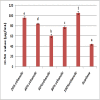Antioxidant activity, α-glucosidase inhibition and phytochemical profiling of Hyophorbe lagenicaulis leaf extracts
- PMID: 31259094
- PMCID: PMC6589327
- DOI: 10.7717/peerj.7022
Antioxidant activity, α-glucosidase inhibition and phytochemical profiling of Hyophorbe lagenicaulis leaf extracts
Abstract
Background: Diabetes mellitus type II (DMT-2) is a widely spread metabolic disorder both in developed and developing countries. The role of oxidative stress is well established in DMT-2 pathogenesis. The synthetic drugs for DMT-2 are associated with serious side complications. Antioxidant and α-glucosidase inhibitory actions of phytochemicals from various plant species are considered as an alternative to synthetic drugs for DMT-2 management. The present study aimed to evaluate the antioxidant activity, α-glucosidase inhibitory potential and phytochemical profiling of Hyophorbe lagenicaulis.
Methods: The total phenolic and flavonoid contents, in vitro antioxidant activity (α, α-diphenyl-β-picrylhydrazyl (DPPH) free radical scavenging and phosphomolybdenum method) and α-glucosidase inhibition of ultrasonicated hydroethanolic H. lagenicaulis leaf extracts were determined spectrophotometrically. The results of DPPH assay and α-glucosidase inhibition were reported in terms of IC50 value. The phytochemical profiling was accomplished by UHPLC-Q-TOF/MS/MS technique.
Results and discussion: Findings leaped 60% ethanolic extract as rich fraction regarding total phenolic and flavonoid contents. The 60% ethanolic fraction was a promising source of natural antioxidants and α-glucosidase inhibitory agents as indicated by anti-radical and enzyme inibitory activities. Kaempferol, rutin, hesperetin 5-O-glucoside, kaempferol-coumaroyl-glucoside, luteolin 3-glucoside, Isorhamnetin-3-O-rutinoside, trimethoxyflavone derivatives and citric acid were identified by UHPLC-Q-TOF-MS/MS. These compounds were believed to be responsible for the strong antioxidant and enzyme inhibitory activity of plant extracts. The extensive metabolite profiling of H. lagenicaulis was carried out the first time as never reported previously. The H. lagenicaulis might be an appropriate choice to manage diabetes mellitus in an alternate way. The findings may be further exploited extensively for toxicity evaluation to proceed with functional food development having antidiabetic attributes.
Keywords: Antidiabetic; Antioxidant; Diabetes mellitus; Hyophorbe lagenicaulis; UHPLC-Q-TOF-MS/MS.
Conflict of interest statement
The authors declare that they have no competing interests.
Figures






Similar articles
-
Antioxidant activity, Hypoglycemic potential and metabolite profiling of Hyophorbe indica leaf extract.Pak J Pharm Sci. 2018 Nov;31(6 (Supplementary):2737-2742. Pak J Pharm Sci. 2018. PMID: 30587488
-
Polyphenol fingerprinting and hypoglycemic attributes of optimized Cycas circinalis leaf extracts.J Sci Food Agric. 2021 Mar 15;101(4):1530-1537. doi: 10.1002/jsfa.10771. Epub 2020 Sep 18. J Sci Food Agric. 2021. PMID: 32869314
-
Antioxidant Activity, α-Glucosidase Inhibition and UHPLC-ESI-MS/MS Profile of Shmar (Arbutus pavarii Pamp).Plants (Basel). 2021 Aug 11;10(8):1659. doi: 10.3390/plants10081659. Plants (Basel). 2021. PMID: 34451703 Free PMC article.
-
UHPLC-MS phytochemical profiling, biological propensities and in-silico studies of Alhagi maurorum roots: a medicinal herb with multifunctional properties.Drug Dev Ind Pharm. 2020 May;46(5):861-868. doi: 10.1080/03639045.2020.1762199. Epub 2020 May 13. Drug Dev Ind Pharm. 2020. PMID: 32352878
-
Toxicological, anticholinesterase, antilipidemic, antidiabetic and antioxidant potentials of Grewia optiva Drummond ex Burret extracts.J Basic Clin Physiol Pharmacol. 2020 Jan 11;31(2):/j/jbcpp.2020.31.issue-2/jbcpp-2019-0220/jbcpp-2019-0220.xml. doi: 10.1515/jbcpp-2019-0220. J Basic Clin Physiol Pharmacol. 2020. PMID: 31926084
Cited by
-
Parkia javanica Edible Pods Reveal Potential as an Anti-Diabetic Agent: UHPLC-QTOF-MS/MS-Based Chemical Profiling, In Silico, In Vitro, In Vivo, and Oxidative Stress Studies.Pharmaceuticals (Basel). 2024 Jul 21;17(7):968. doi: 10.3390/ph17070968. Pharmaceuticals (Basel). 2024. PMID: 39065816 Free PMC article.
-
Antioxidant and Hypoglycemic Potential of Phytogenic Selenium Nanoparticle- and Light Regime-Mediated In Vitro Caralluma tuberculata Callus Culture Extract.ACS Omega. 2024 Apr 24;9(18):20101-20118. doi: 10.1021/acsomega.3c10222. eCollection 2024 May 7. ACS Omega. 2024. PMID: 38737082 Free PMC article.
-
In vitro anti-diabetic effects and phytochemical profiling of novel varieties of Cinnamomum zeylanicum (L.) extracts.PeerJ. 2020 Nov 2;8:e10070. doi: 10.7717/peerj.10070. eCollection 2020. PeerJ. 2020. PMID: 33194379 Free PMC article.
-
Prospective Nutraceutical Effects of Cinnamon Derivatives Against Insulin Resistance in Type II Diabetes Mellitus-Evidence From the Literature.Dose Response. 2023 Sep 10;21(3):15593258231200527. doi: 10.1177/15593258231200527. eCollection 2023 Jul-Sep. Dose Response. 2023. PMID: 37701673 Free PMC article. Review.
-
In vitro α-glucosidase inhibitory activity of Tamarix nilotica shoot extracts and fractions.PLoS One. 2022 Mar 14;17(3):e0264969. doi: 10.1371/journal.pone.0264969. eCollection 2022. PLoS One. 2022. PMID: 35286313 Free PMC article.
References
-
- Aadesariya MK, Ram VR, Dave PN. Evaluation of antioxidant activities by use of various extracts from Abutilon pannosum and Grewia tenax leaves in the kachchh region. MOJ Food Processing & Technology. 2017;17(1):359.
-
- Adamska-Patruno E, Billing-Marczak K, Orlowski M, Gorska M, Krotkiewski M, Kretowski A. A synergistic formulation of plant extracts decreases postprandial glucose and insulin peaks: results from two randomized, controlled, cross-over studies using real-world meals. Nutrients. 2018;10(8):956. doi: 10.3390/nu10080956. - DOI - PMC - PubMed
-
- Akash M, Rehman K, Rasool F, Sethi A, Abrar M, Irshad A, Abid A, Murtaza G. Alternate therapy of type 2 diabetes mellitus (T2DM) with Nigella (Ranunculaceae) Journal of Medicinal Plants Research. 2011;5(31):6885–6889.
-
- Baba SA, Malik SA. Determination of total phenolic and flavonoid content, antimicrobial and antioxidant activity of a root extract of Arisaema jacquemontii Blume. Journal of Taibah University for Science. 2015;9(4):449–454. doi: 10.1016/j.jtusci.2014.11.001. - DOI
LinkOut - more resources
Full Text Sources

